Sommerville I. Software Engineering (9th edition)
Подождите немного. Документ загружается.


484 Chapter 18 ■ Distributed software engineering
The major difficulty in distributed systems is establishing a security policy
that can be reliably applied to all of the components in a system. As I discussed
in Chapter 11, a security policy sets out the level of security to be achieved by a
system. Security mechanisms, such as encryption and authentication, are used to
enforce the security policy. The difficulties in a distributed system arise because
different organizations may own parts of the system. These organizations may
have mutually incompatible security policies and security mechanisms. Security
compromises may have to be made in order to allow the systems to work
together.
The quality of service (QoS) offered by a distributed system reflects the system’s
ability to deliver its services dependably and with a response time and throughput
that is acceptable to its users. Ideally, the QoS requirements should be specified in
advance and the system designed and configured to deliver that QoS. Unfortunately,
this is not always practicable, for two reasons:
1. It may not be cost effective to design and configure the system to deliver a high
QoS under peak load. This could involve making resources available that are
unused for much of the time. One of the main arguments for ‘cloud computing’
is that it partially addresses this problem. Using a cloud, it is easy to add
resources as demand increases.
2. The QoS parameters may be mutually contradictory. For example, increased
reliability may mean reduced throughput, as checking procedures are intro-
duced to ensure that all system inputs are valid.
QoS is particularly critical when the system is dealing with time-critical data
such as sound or video streams. In these circumstances, if the QoS falls below a
threshold value then the sound or video may become so degraded that it is
impossible to understand. Systems dealing with sound and video should include
QoS negotiation and management components. These should evaluate the QoS
requirements against the available resources and, if these are insufficient, nego-
tiate for more resources or for a reduced QoS target.
In a distributed system, it is inevitable that failures will occur, so the system has to
be designed to be resilient to these failures. Failure is so ubiquitous that one flippant
definition of a distributed system suggested by Leslie Lamport, a prominent distrib-
uted systems researcher, is:
“You know that you have a distributed system when the crash of a system that
you’ve never heard of stops you getting any work done.”
Failure management involves applying the fault tolerance techniques discussed in
Chapter 13. Distributed systems should therefore include mechanisms for discover-
ing if a component of the system has failed, should continue to deliver as many serv-
ices as possible in spite of that failure and, as far as possible, should automatically
recover from the failure.
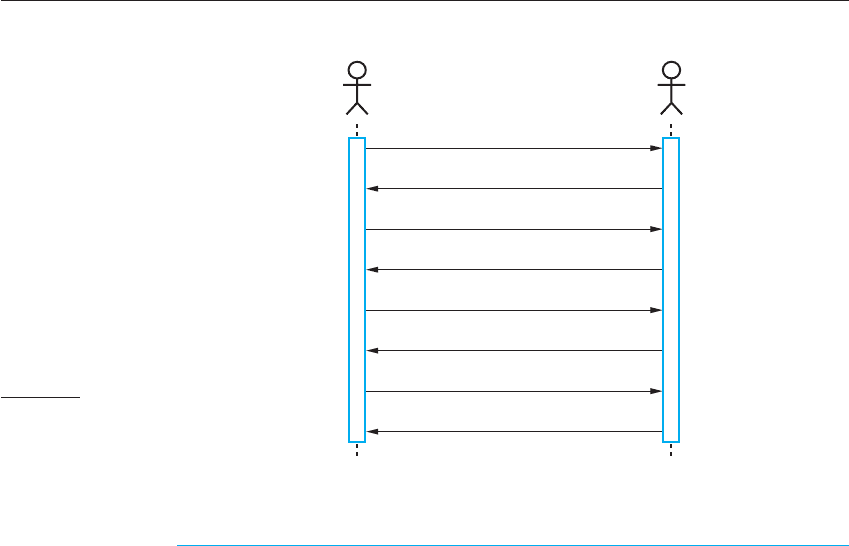
18.1 ■ Distributed systems issues 485
18.1.1 Models of interaction
There are two fundamental types of interaction that may take place between the com-
puters in a distributed computing system: procedural interaction and message-based
interaction. Procedural interaction involves one computer calling on a known service
offered by some other computer and (usually) waiting for that service to be delivered.
Message-based interaction involves the ‘sending’ computer defining information
about what is required in a message, which is then sent to another computer.
Messages usually transmit more information in a single interaction than a procedure
call to another machine.
To illustrate the difference between procedural and message-based interaction,
consider a situation where you are ordering a meal in a restaurant. When you have a
conversation with the waiter, you are involved in a series of synchronous, procedural
interactions that define your order. You make a request; the waiter acknowledges that
request; you make another request, which is acknowledged; and so on. This is com-
parable to components interacting in a software system where one component calls
methods from other components. The waiter writes down your order along with the
order of other people with you. He or she then passes this order, which includes
details of everything that has been ordered, to the kitchen to prepare the food.
Essentially, the waiter is passing a message to the kitchen staff defining the food to
be prepared. This is message-based interaction.
I have illustrated this in Figure 18.1, which shows the synchronous ordering
process as a series of calls and in Figure 18.2, which shows a hypothetical XML
message that defines an order made by the table of three people. The difference
between these forms of information exchange is clear. The waiter takes the order as
a series of interactions, with each interaction defining part of the order. However,
Tomato soup please
W
aiter Diner
What would you like?
And to follow?
Fillet steak
How would you like it cooked?
Rare please
With salad or french fries?
Salad please
Etc.
Figure 18.1 Procedural
interaction between a
diner and a waiter

486 Chapter 18 ■ Distributed software engineering
the waiter has a single interaction with the kitchen where the message defines the
complete order.
Procedural communication in a distributed system is usually implemented
using remote procedure calls (RPCs). In RPC one component calls another compo-
nent as if it was a local procedure or method. The middleware in the system inter-
cepts this call and passes it to a remote component. This carries out the required
computation and, via the middleware, returns the result to the calling component.
In Java, remote method invocations (RMI) are comparable with, though not identi-
cal to, RPCs. The RMI framework handles the invocation of remote methods in a
Java program.
RPCs require a ‘stub’ for the called procedure to be accessible on the computer
that is initiating the call. The stub is called and it translates the procedure parameters
into a standard representation for transmission to the remote procedure. Through the
middleware, it then sends the request for execution to the remote procedure. The
remote procedure uses library functions to convert the parameters into the required
format, carries out the computation, and then communicates the results via the ‘stub’
that is representing the caller.
Message-based interaction normally involves one component creating a message
that details the services required from another component. Through the system
middleware, this is sent to the receiving component. The receiver parses the mes-
sage, carries out the computations, and creates a message for the sending component
with the required results. This is then passed to the middleware for transmission to
the sending component.
A problem with the RPC approach to interaction is that both the caller and the
callee need to be available at the time of the communication, and they must know
how to refer to each other. In essence, an RPC has the same requirements as a local
procedure or method call. By contrast, in a message-based approach, unavailability
can be tolerated as the message simply stays in a queue until the receiver becomes
available. Furthermore, it is not necessary for the sender and receiver of the message
to be aware of each other. They simply communicate with the middleware, which is
responsible for ensuring that messages are passed to the appropriate system.
Figure 18.2
Message-based
interaction
between a
waiter and the
kitchen staff
<starter>
<dish name = “soup” type = “tomato” />
<dish name = “soup” type = “fish” />
<dish name = “pigeon salad” />
</starter>
<main course>
<dish name = “steak” type = “sirloin” cooking = “medium” />
<dish name = “steak” type = “fillet” cooking = “rare” />
<dish name = “sea bass”>
</main>
<accompaniment>
<dish name = “french fries” portions = “2” />
<dish name = “salad” portions = “1” />
</accompaniment>
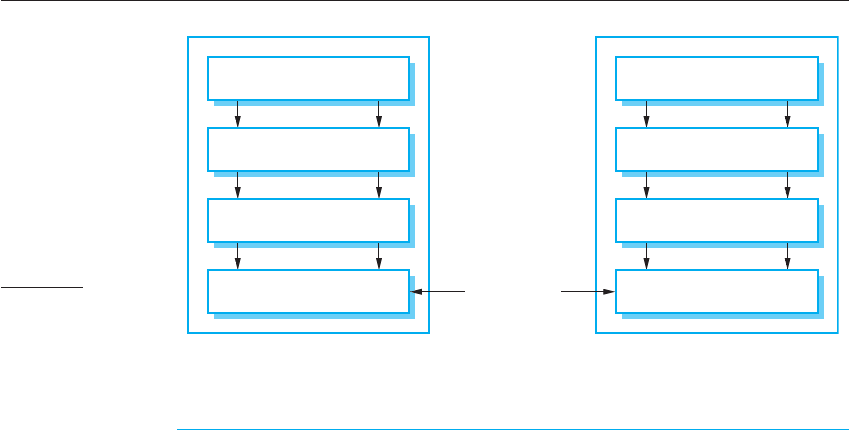
18.1 ■ Distributed systems issues 487
18.1.2 Middleware
The components in a distributed system may be implemented in different program-
ming languages and may execute on completely different types of processor. Models
of data, information representation, and protocols for communication may all be dif-
ferent. A distributed system therefore requires software that can manage these
diverse parts, and ensure that they can communicate and exchange data.
The term ‘middleware’ is used to refer to this software—it sits in the middle
between the distributed components of the system. This is illustrated in Figure 18.3,
which shows that middleware is a layer between the operating system and appli-
cation programs. Middleware is normally implemented as a set of libraries, which
are installed on each distributed computer, plus a run-time system to manage
communications.
Bernstein (1996) describes types of middleware that are available to support dis-
tributed computing. Middleware is general-purpose software that is usually bought
off the shelf rather than written specially by application developers. Examples of
middleware include software for managing communications with databases, transac-
tion managers, data converters, and communication controllers.
In a distributed system, middleware normally provides two distinct types of support:
1. Interaction support, where the middleware coordinates interactions between dif-
ferent components in the system. The middleware provides location trans-
parency in that it isn’t necessary for components to know the physical locations
of other components. It may also support parameter conversion if different pro-
gramming languages are used to implement components, event detection, and
communication, etc.
2. The provision of common services, where the middleware provides reusable
implementations of services that may be required by several components in the
distributed system. By using these common services, components can easily
interoperate and provide user services in a consistent way.
Logical
Interaction
Information
Exchange and
Common Services
Coordinated
Operation
Application Components
Middleware
Operating System
Networking
System 1
Application Components
Middleware
Operating System
Networking
System 2
Physical
Connectivity
Figure 18.3
Middleware in a
distributed system
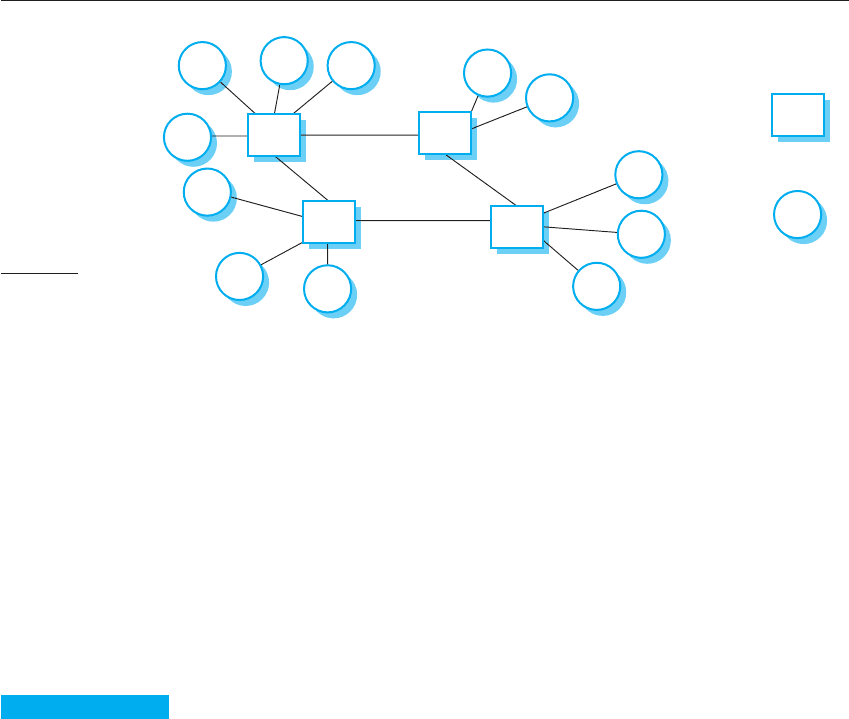
488 Chapter 18 ■ Distributed software engineering
I have already given examples of the interaction support that middleware can pro-
vide in Section 18.1.1. You use middleware to support remote procedure and
remote method calls, message exchange, etc.
Common services are those services that may be required by different compo-
nents irrespective of the functionality of these components. As I discussed in
Chapter 17, these may include security services (authentication and authorization),
notification and naming services, and transaction management services, etc. You
can think of these common services as being provided by a middleware container.
You then deploy your component in that container and it can access and use these
common services.
18.2 Client–server computing
Distributed systems that are accessed over the Internet are normally organized as
client–server systems. In a client–server system, the user interacts with a program
running on their local computer (e.g., a web browser or phone-based application).
This interacts with another program running on a remote computer (e.g., a web
server). The remote computer provides services, such as access to web pages, which
are available to external clients. This client–server model, as I discussed in Chapter 6,
is a very general architectural model of an application. It is not restricted to applica-
tions distributed across several machines. You can also use it as a logical interaction
model where the client and the server run on the same computer.
In a client–server architecture, an application is modeled as a set of services that
are provided by servers. Clients may access these services and present results to end
users (Orfali and Harkey, 1998). Clients need to be aware of the servers that are
available but do not know of the existence of other clients. Clients and servers are
separate processes, as shown in Figure 18.4. This illustrates a situation in which
there are four servers (s1–s4), that deliver different services. Each service has a set of
associated clients that access these services.
s1
s2
s3
s4
c1
c2
c3
c4
c5
c6
c7
c8
c9
c10
c11
c12
Client Process
Server Process
Figure 18.4 Client–server
interaction

18.2 ■ Client–server computing 489
Figure 18.4 shows client and server processes rather than processors. It is normal
for several client processes to run on a single processor. For example, on your PC,
you may run a mail client that downloads mail from a remote mail server. You may
also run a web browser that interacts with a remote web server and a print client that
sends documents to a remote printer. Figure 18.5 illustrates the situation where the
12 logical clients shown in Figure 18.4 are running on six computers. The four server
processes are mapped onto two physical server computers.
Several different server processes may run on the same processor but, often,
servers are implemented as multiprocessor systems in which a separate instance of
the server process runs on each machine. Load-balancing software distributes
requests for service from clients to different servers so that each server does the same
amount of work. This allows a higher volume of transactions with clients to be han-
dled, without degrading the response to individual clients.
Client–server systems depend on there being a clear separation between the pres-
entation of information and the computations that create and process that information.
Consequently, you should design the architecture of distributed client–server systems
so that they are structured into several logical layers, with clear interfaces between
these layers. This allows each layer to be distributed to a different computer. Figure
18.6 illustrates this model, showing an application structured into four layers:
• A presentation layer that is concerned with presenting information to the user and
managing all user interaction;
• A data management layer that manages the data that is passed to and from the
client. This layer may implement checks on the data, generate web pages, etc.;
• An application processing layer that is concerned with implementing the logic of
the application and so providing the required functionality to end users;
• A database layer that stores the data and provides transaction management
services, etc.
The following section explains how different client–server architectures distrib-
ute these logical layers in different ways. The client–server model also underlies the
notion of software as a service (SaaS), an increasingly important way of deploying
software and accessing it over the Internet. I discuss this in Section 18.4.
Network
CC1 CC3CC2
SC2
CC4 CC6CC5
SC1
Server
Computer
Client
Computer
c1 c2 c3, c4s1, s2
c5, c6, c7 c8, c9 c10, c11, c12s3, s4
Figure 18.5 Mapping of
clients and servers to
networked computers
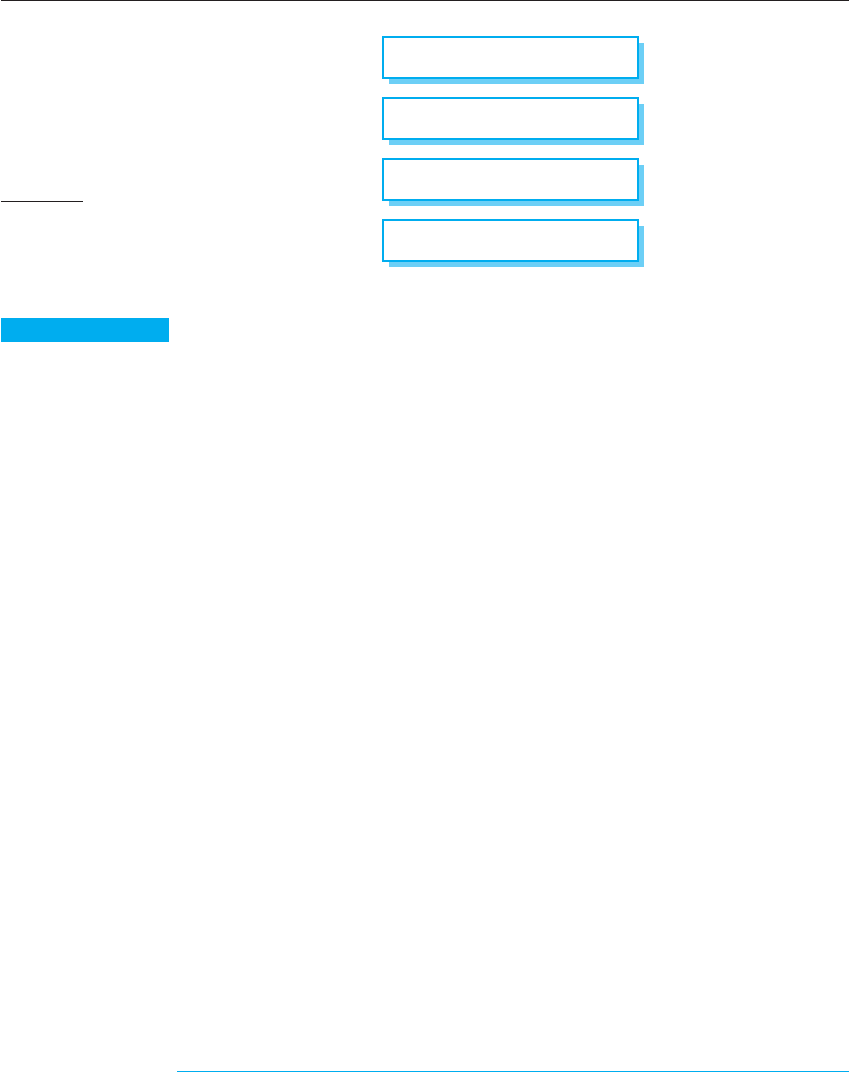
490 Chapter 18 ■ Distributed software engineering
18.
3
Architectural patterns for distributed systems
As I explained in the introduction to this chapter, designers of distributed systems
have to organize their system designs to find a balance between performance,
dependability, security, and manageability of the system. There is no universal
model of system organization that is appropriate for all circumstances so various dis-
tributed architectural styles have emerged. When designing a distributed application,
you should choose an architectural style that supports the critical non-functional
requirements of your system.
In this section, I discuss five architectural styles:
1. Master-slave architecture, which is used in real-time systems in which guaran-
teed interaction response times are required.
2. Two-tier client–server architecture, which is used for simple client–server systems,
and in situations where it is important to centralize the system for security reasons.
In such cases, communication between the client and server is normally encrypted.
3. Multitier client–server architecture, which is used when there is a high volume
of transactions to be processed by the server.
4. Distributed component architecture, which is used when resources from differ-
ent systems and databases need to be combined, or as an implementation model
for multi-tier client–server systems.
5. Peer-to-peer architecture, which is used when clients exchange locally stored infor-
mation and the role of the server is to introduce clients to each other. It may also be
used when a large number of independent computations may have to be made.
18.3.1 Master-slave architectures
Master-slave architectures for distributed systems are commonly used in real-
time systems where there may be separate processors associated with data acqui-
sition from the system’s environment, data processing, and computation and
Application Processing Layer
Data Management Layer
Presentation Layer
Database Layer
Figure 18.6 Layered
architectural model for
client–server application
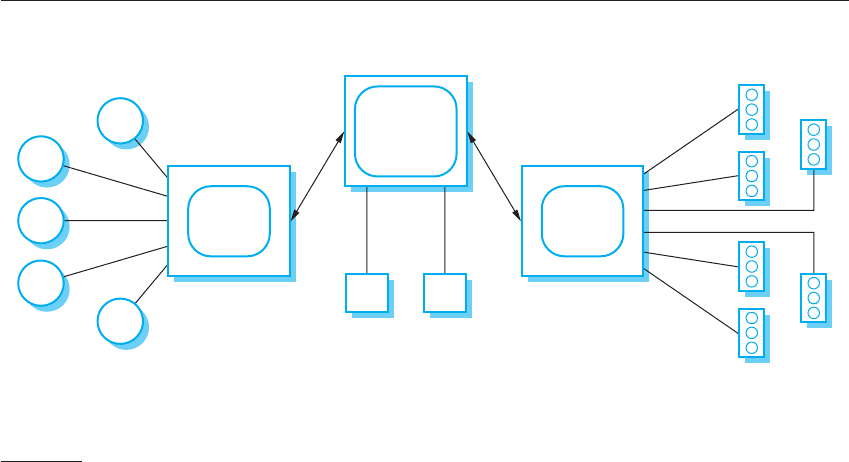
18.3 ■ Architectural patterns for distributed systems 491
actuator management. Actuators, as I discuss in Chapter 20, are devices con-
trolled by the software system that act to change the system’s environment. For
example, an actuator may control a valve and change its state from ‘open’ to
‘closed’. The ‘master’ process is usually responsible for computation, coordina-
tion, and communications and it controls the ‘slave’ processes. ‘Slave’ processes
are dedicated to specific actions, such as the acquisition of data from an array of
sensors.
Figure 18.7 illustrates this architectural model. It is a model of a traffic control
system in a city and has three logical processes that run on separate processors. The
master process is the control room process, which communicates with separate slave
processes that are responsible for collecting traffic data and managing the operation
of traffic lights.
A set of distributed sensors collects information on the traffic flow. The sen-
sor control process polls the sensors periodically to capture the traffic flow infor-
mation and collates this information for further processing. The sensor processor
is itself polled periodically for information by the master process that is con-
cerned with displaying traffic status to operators, computing traffic light
sequences and accepting operator commands to modify these sequences. The
control room system sends commands to a traffic light control process that con-
verts these into signals to control the traffic light hardware. The master control
room system is itself organized as a client–server system, with the client
processes running on the operator’s consoles.
You use this master-slave model of a distributed system in situations where you
can predict the distributed processing that is required, and where processing can be
easily localized to slave processors. This situation is common in real-time systems,
where it is important to meet processing deadlines. Slave processors can be used for
computationally intensive operations, such as signal processing and the management
of equipment controlled by the system.
Traffic Lights
Light
Control
Process
Traffic Light Control
Processor
Operator Consoles
Traffic Flow Sensors
and Cameras
Slave
Coordination
and Display
Process
Control Room
Processor
Master
Sensor
Control
Process
Sensor
Processor
Slave
Figure 18.7 A traffic
management system
with a master-slave
architecture
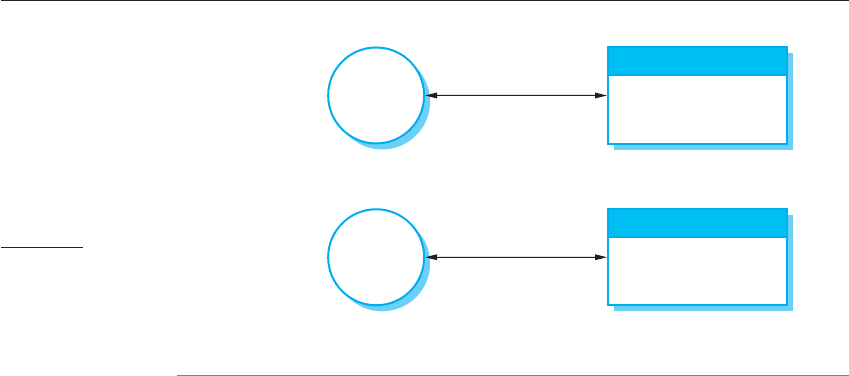
492 Chapter 18 ■ Distributed software engineering
18.3.2 Two-tier client–server architectures
In Section 18.2, I discussed the general form of client–server systems in which part of
the application system runs on the user’s computer (the client), and part runs on a
remote computer (the server). I also presented a layered application model (Figure 18.6)
where the different layers in the system may execute on different computers.
A two-tier client–server architecture is the simplest form of client–server archi-
tecture. The system is implemented as a single logical server plus an indefinite num-
ber of clients that use that server. This is illustrated in Figure 18.8, which shows two
forms of this architectural model:
1. A thin-client model, where the presentation layer is implemented on the client
and all other layers (data management, application processing, and database) are
implemented on a server. The client software may be a specially written pro-
gram on the client to handle presentation. More often, however, a web browser
on the client computer is used for presentation of the data.
2. A fat-client model, where some or all of the application processing is carried out on
the client. Data management and database functions are implemented on the server.
The advantage of the thin-client model is that it is simple to manage the clients.
This is a major issue if there are a large number of clients, as it may be difficult and
expensive to install new software on all of them. If a web browser is used as the
client, there is no need to install any software.
The disadvantage of the thin-client approach, however is that it may place a heavy
processing load on both the server and the network. The server is responsible for all
computation and this may lead to the generation of significant network traffic
between the client and the server. Implementing a system using this model may
therefore require additional investment in network and server capacity. However,
browsers may carry out some local processing by executing scripts (e.g., Javascript)
in the web page that is accessed by the browser.
The fat-client model makes use of available processing power on the computer
running the client software, and distributes some or all of the application processing
Thin-Client
Model
Fat-Client
Model
Client
Client
Server
Database
Data Management
Application Processing
Presentation
Server
Database
Data Management
Presentation
Application Processing
Figure 18.8 Thin- and
fat-client architectural
models
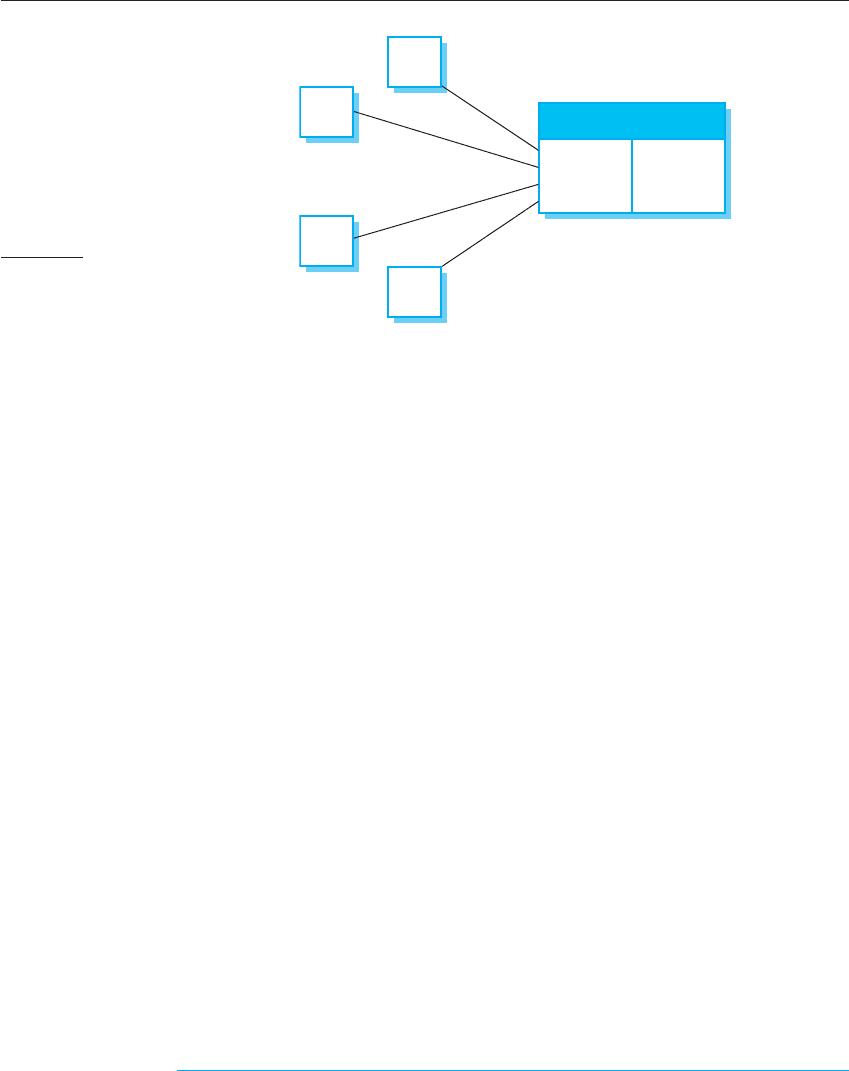
18.3 ■ Architectural patterns for distributed systems 493
and the presentation to the client. The server is essentially a transaction server that
manages all database transactions. Data management is straightforward as there is
no need to manage the interaction between the client and the application processing
system. Of course, the problem with the fat-client model is that it requires additional
system management to deploy and maintain the software on the client computer.
An example of a situation in which a fat-client architecture is used is in a bank ATM
system, which delivers cash and other banking services to users. The ATM is the client
computer and the server is, typically, a mainframe running the customer account data-
base. A mainframe computer is a powerful machine that is designed for transaction pro-
cessing. It can therefore handle the large volume of transactions generated by ATMs,
other teller systems, and online banking. The software in the teller machine carries out a
lot of the customer-related processing associated with a transaction.
Figure 18.9 shows a simplified version of the ATM system organization. Notice
that the ATMs do not connect directly to the customer database, but rather to a
teleprocessing monitor. A teleprocessing (TP) monitor is a middleware system that
organizes communications with remote clients and serializes client transactions for
processing by the database. This ensures that transactions are independent and do
not interfere with one other. Using serial transactions means that the system can
recover from faults without corrupting the system data.
Whereas a fat-client model distributes processing more effectively than a thin-
client model, system management is more complex. Application functionality is
spread across many computers. When the application software has to be changed,
this involves reinstallation on every client computer. This can be a major cost if there
are hundreds of clients in the system. The system may have to be designed to support
remote software upgrades and it may be necessary to shut down all system services
until the client software has been replaced.
18.3.3 Multi-tier client–server architectures
The fundamental problem with a two-tier client–server approach is that the logical
layers in the system—presentation, application processing, data management, and
database—must be mapped onto two computer systems: the client and the server.
Account Server
Customer
Account
Database
Tele-
Processing
Monitor
ATM
ATM
ATM
ATM
Figure 18.9 A fat-client
architecture for an ATM
system
